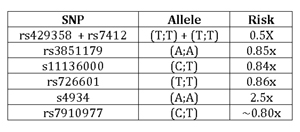What I was hoping to see was a compilation of all the information out there. See, my APOE data suggests that I am at a lower risk. But what if all my other genes are of the wrong type and put me at a higher risk? Then I might be at a higher risk than I think I am.
And my situation is better than people who have APOE gene versions that put them at a higher risk. What if all of their other genes put them at a lower risk? Now they are worried for no reason.
This points to one of the big issues with genetic tests and complex genetic diseases. Right now we know a bit about some of the genes involved but we don’t yet know the whole story.
It is kind of like having a whiteboard with a vast, awful, Jimmy Neutronesque formula scrawled across it. This is our genetic risk for getting something like Alzheimer’s.
Unfortunately, a blanket of ignorance hides most of the formula from us. We can only get a glimpse of one small part of it. What we then try to do is figure out our risk from that glimpse.
So let’s say we manage to uncover a bit of the blanket in the corner and we see a 0.5X. Does that mean that I am half as likely to get Alzheimer’s? Hardly. We have managed to see a piece of the whole formula but the rest remains hidden.
My APOE status is really just a bit of the formula for my Alzheimer’s risk peeking out from under the blanket. I don’t know the rest of the formula and so don’t know the rest of the risk.
APOE status is a well-studied risk that we know a lot about. We have completely uncovered it on our whiteboard. Some studies are staring to reveal other parts of the board but they aren’t completely clear yet. This is probably why 23andMe left them out.
I decided to look at the hazy parts of my equation using good old SNPedia. Remember, they have lots of information about DNA variants and disease that isn’t as filtered as is 23andMe’s.
Here is what I found when I put my data from 23andMe through SNPedia. I have listed the SNP, what I have at the SNP (the allele), and my risk for Alzheimer’s for those that give me a higher or lower chance for Alzheimer’s. I haven’t put in the ones that have normal risk.

I came out very well here. I am at a much lower risk for getting Alzheimer’s when I look at these SNPs. Yay!
But what if I just had s4934 data? I would come out thinking I was at a higher risk when I am actually at a lower one. Lots of needless worry over nothing…
Now I shouldn’t get complacent, this is still only a bit of my risk for Alzheimer’s. There may be some killer SNP lurking in my DNA, ready to spring Alzheimer’s on me. Or a long list of small, not-yet-discovered SNPs that will eat away at my supposed lower risk for Alzheimer’s. We just don’t know yet.
And I haven’t even begun to talk about environmental impacts. We know so little about that one with Alzheimer’s that we haven’t even found the whiteboard yet!
37.7749295 -122.4194155
 Many genetic tests just uncover one small bit of
Many genetic tests just uncover one small bit of
